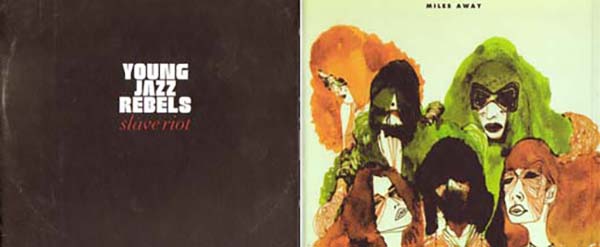
by Tim Owen
May 15, 2010
Tim Owen looks at two examples of the jazz output of US hip hop artist Madlib.
The Last Electro-Acoustic Space Jazz & Percussion Ensemble
“Miles Away”
(Stones Throw Records)
Young Jazz Rebels
“Slave Riot”
(Stones Throw Records)
Both of these albums are gorgeously packaged in gatefold, thick card sleeves with obi strips that loudly proclaim them to be Produced by Madlib. Now this name may not be familiar to a mainstream jazz audience, but in left-field hip-hop circles Madlib is a name to conjure with, a prolific and lauded producer/DJ. who, since the late 90s, has operated under various alternative pseudonyms (Quasimoto, Beat Konducta), and worked with many of the game?s most adventurous players, from MF Doom to Talib Kweli. Lately he?s won plaudits as producer of Erykah Badu?s New Amerykah albums.
But we aren?t interested in that part of the Madlib story. The Jazzmann?s interest takes root in 2000 with the creation of Madlib?s ?virtual jazz band?, Yesterdays New Quintet. As far as I can tell, Yesterdays New Quintet was comprised of four pseudonymous characters alongside one Otis Jackson Jnr., a.k.a. Madlib himself, operating for once under his given name. In 2007 the Quintet experiment was expanded under the Yesterdays Universe banner, resulting in a ?various artists? album of disparate but cohesive flavour which is, as Stone?s Throw?s own website so neatly puts it, “more tailored to fans of Sun Ra than Sa-Ra”.
Of the artists featured on the Yesterdays Universe album The Last Electro-Acoustic Space Jazz & Percussion Ensemble were the first with an independent release, in the form of the Japan-only “Summer Suite” and “Fall Suite” titles (Stones Throw, 2007). Finally, with “Miles Away”, the group reaches maturity, and we can all get our hands on the product. “Miles Away” is a jazz fusion album, evidently indebted to the late Impulse! canon of recordings (think, particularly, of the title track from Alice Coltrane?s “Journey In Satchidananda”) and much that came after, from Pharaoh Sanders through Lonnie Liston Smith to Gill Scott-Heron. What distinguishes the Ensemble?s recording from those of their predecessors is a heavy, heavy low end that, at times, beefs Jackson?s bass drum up to sound-system competition level. At other times electric bass lines provide a solid rhythmic anchor for Latin-inflected, deep-space grooves that are embellished with piano vamps and the obligatory wash of vibes, Moog, Fender Rhodes, Wurlitzer, sitar, and even electric flute.
“Miles Away” is, I think, a genuine ensemble effort (ten other names are credited with specific instrumentation), albeit one that Madlib “tweaked and revised for over two years”. Perhaps despite that fact, it?s very well unified. The tracks may all be variations on one blueprint, but they are sufficiently distinctive to reward attentive listening. The coloration is always impeccably tasteful. The closing “The Trane and the Pharaoh” and “Waltz for Woody (For Woody Shaw)”, the latter being something of a showcase for Jackson?s studio-enhanced percussion skills, are just two highlights of a very consistently rewarding set that works best over the full duration, as energized mood music. It may be avowedly retro, in both its inspiration and its packaging, but its bang-up-to-now production makes “Miles Away” a powerful proposition.
Another release from a Yesterdays Universe offshoot is a more patchy affair, though it?s also the more quirky and adventurous of the two releases. The Young Jazz Rebels may be either a genuine octet effort or another roll-call of Madlib pseudonyms; certainly the album is more obviously a studio contrivance than is “Miles Away”. In any case, “Slave Riot” is somewhat dual natured. Some of the numbers are solid jazz fusion, but the general flavour is purposefully avant-garde, with many tracks bordering on sound collage. Among the former is “Forces Unseen”, which beautifully dovetails two related linear grooves, only to ruin everything at the last minute by dropping a crude and jarringly unrelated saxophone solo over a sudden fade out; among the latter is the title suite, the two parts of which are, at over six and a half minutes, by far the longest, as well as the most abstract tracks here. Most tracks come in at under three minutes, and there are eighteen of them here, including one, “Theme from Illusion Suite”, that?s co-credited to Stanley Cowell. It?s nice to see that debt so clearly flagged; “Illusion Suite” is a 1999 album by Cowell on which Jimmy Hopps? drumming is a masterclass of break beats.
On “Slave Riot” it?s as if (as with Frank Zappa?s Guitar albums, on which all of the solos from Zappa?s canned concert recordings were compiled) just the freakiest, most abstract moments of collective improvisation have been compiled from hours of tapes, and then (unlike Zappa?s work) zapped in a freak-hop blender. The whole thing is obviously supposed to sound like an exercise in sampladelic collage, of recontextualised breaks recovered from vintage vinyl. The static crackle of degraded vinyl crops up throughout. And somehow, sometimes, the trick pays off handsomely, when rhythm lines cohere and suddenly thrust forward, or whenever the listener is seduced by some filigree tweak into the thicket of detail and smothered with incident. With me, that happened a lot. Unlike the Ensemble?s work, needless to say, it?s impossible to imagine the Rebels material played live, but for a concentrated dose of experimentation “Slave Riot” is heady stuff, and the album would be perfect for the attention-deficient po-mo wannabe jazzer in your life. For one track that does stand up on its own, try “Nappy Headed History”, which has a mellowly resonant double bass line and a slinky rhythm; it?s just a pity it fades out so abruptly at the end.
blog comments powered by Disqus